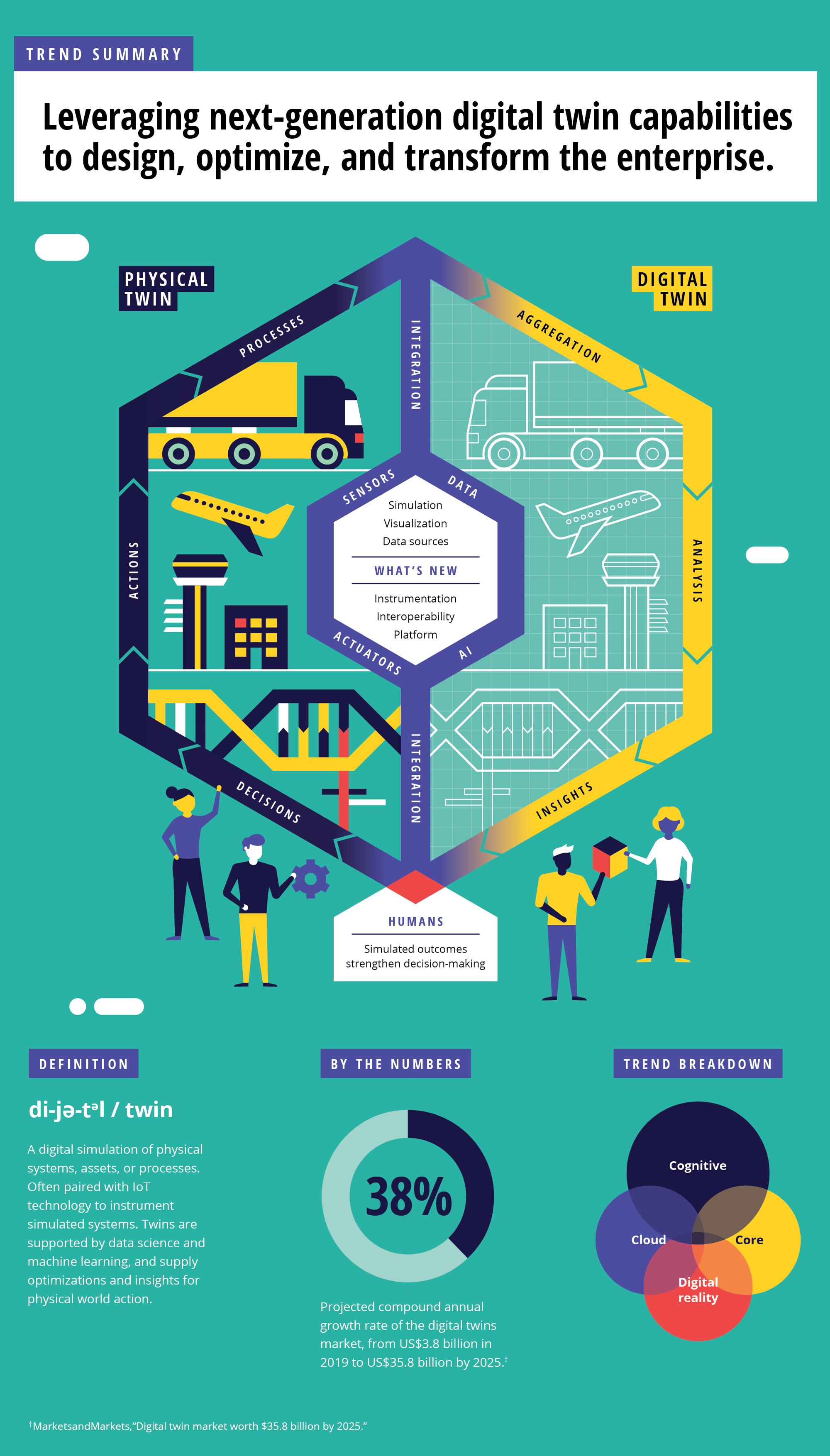Digital twins are multiplying as their capabilities and sophistication grow but require integrating systems and data across entire organizational ecosystems.
Digital twin would enable you to collaborate virtually, intake sensor data and simulate conditions quickly, understand what-if scenarios clearly, predict results more accurately, and output instructions to manipulate the physical world.
Today, companies are using digital twin capabilities in a variety of ways. They are becoming essential tools for optimizing entire value chains and innovating new products, capturing and analyzing massive amounts of data to build digital models, creating highly accurate diagnoses, uses a detailed virtual model in planning, maintenance, and disaster readiness projects.
Digital twins can simulate any aspect of a physical object or process, but they all capture and utilize data that represents the physical world.
Recent MarketsandMarkets research predict The digital twins market—worth US$3.8 billion in 2019—is projected to reach US$35.8 billion in value by 2025. The trend is gaining momentum thanks to rapidly evolving simulation and modeling capabilities, better interoperability and IoT sensors, and more availability of tools and computing infrastructure. IDC projects that by 2022, 40% of IoT platform vendors will integrate simulation platforms, systems, and capabilities, with 70% of manufacturers using the technology to conduct process simulations and scenario evaluations.
At the same time, access to larger volumes of data is making it possible to create simulations that are more detailed and dynamic than ever.
Models + data = insights and real value
It capabilities began as a tool to streamline the design process and eliminate many aspects of prototype testing. It helps engineers identify potential manufacturability, quality, and durability issues—all before the designs are finalized. Thus moving into production more efficiently and at a lower cost.
Beyond design, it transform the way companies perform predictive maintenance of products and machinery in the field. Embedded sensors feed data in real time, making it possible not only to identify malfunctions but to tailor service and maintenance plans.
It help optimize supply chains, distribution and fulfillment operations, and even the individual performance of the workers involved in each.
Smart city initiatives are also using digital twins for applications addressing traffic congestion remediation, urban planning, and much more.
What’s new?
Digital twin capabilities has accelerated due to a number of factors:
Simulation. The tools are growing in power and sophistication. It is now possible to design complex what-if simulations, backtrack from detected real-world conditions, and perform millions of simulation processes without overwhelming systems. Finally, machine learning functionality is enhancing the depth and usefulness of insights.
New sources of data. Data from real-time asset monitoring technologies can be incorporated into simulations. Likewise, IoT sensors embedded in machinery or throughout supply chains can feed operational data directly into simulations, enabling continuous real-time monitoring.
Interoperability. The ability to integrate digital technology with the real world can be attributed to enhanced industry standards for communications between IoT sensors, operational technology hardware, and vendor efforts to integrate with diverse platforms.
Visualization. Advanced data visualization can filtering and distilling information in real time. The latest data visualization tools go far beyond basic dashboards and standard visualization capabilities to include interactive 3D, VR & AR-based visualizations, AI-enabled, and real-time streaming.
Instrumentation. With IoT sensors improvements in networking and security, control systems can be leveraged to have more granular, timely, and accurate information on real-world conditions to integrate with the virtual models.
Platform. Some software companies are making significant investments in cloud-based platforms, IoT, and analytics capabilities that will enable them to capitalize on the digital twins trend. Some of these investments are part of an ongoing effort to streamline the development of industry-specific digital twin use cases.
Costs versus benefits
The AI and machine learning algorithms that power digital twins require large volumes of data, and in many cases, data from the sensors on the production floor may have been corrupted, lost, or simply not collected consistently in the first place. So teams should begin collecting data now, particularly in areas with the largest number of issues and the highest outage costs. Taking steps to develop the necessary infrastructure and data management approach now can help shorten your time to benefit.
Even in cases where digital twin simulations are being created for new processes, systems, and devices, it’s not always possible to perfectly instrument the process. Organizations need to look to proxies or things that are possible to detect.
Balancing the cost/benefit analysis is critical. Most use cases, however, require only a modest number of strategically placed sensors to detect key inputs, outputs, and stages within the process.
Models beyond
Organizations making the transition from selling products to selling bundled products and services, or selling as-a-service, are pioneering new digital twin use cases. Connecting a digital twin to embedded sensors and using it for financial analysis and projections enables better refinement and optimization of projections, pricing, and upsell opportunities.
Modeling the digital future
More organizations may explore opportunities to use digital twins to optimize processes, make data-driven decision in real time, and design new products, services, and business models.
Longer term, require integrating systems and data across entire ecosystems. Creating a digital simulation of the complete customer life cycle or of a supply chain that includes not only first-tier suppliers but their suppliers, may provide an insight-rich macro view of operations, but it would also require incorporating external entities into internal digital ecosystems. In the future, expect to see companies use blockchain to break down information silos, and then validate and feed that information into simulations. This could free up previously inaccessible data in volumes sufficient to make simulations more detailed, dynamic, and potentially valuable than ever.

No comments:
Post a Comment